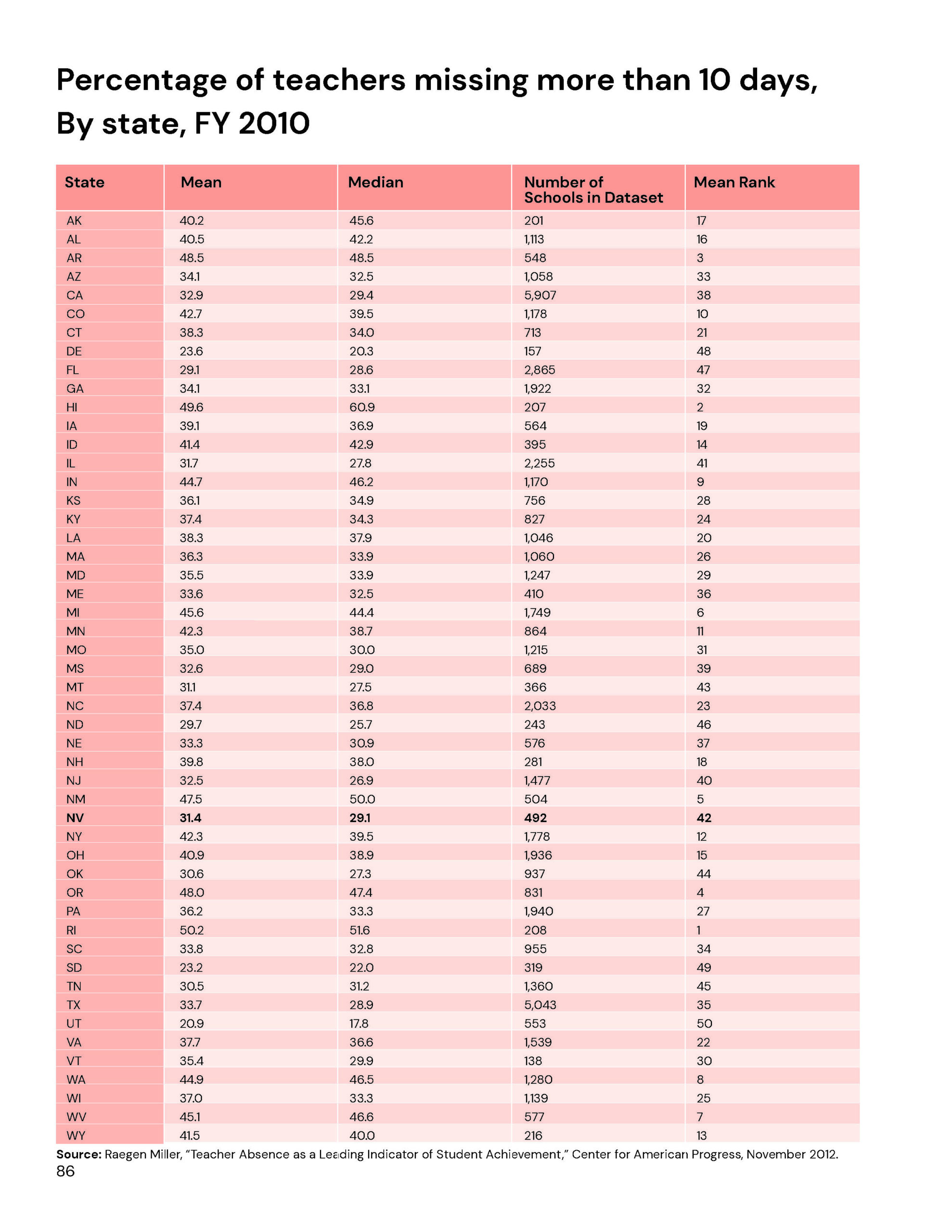Teacher Absenteeism
According to statistics compiled by the left-leaning Center for American Progress, 31.4% of Nevada’s schoolteachers missed more than 10 days of school during the 2009-2010 school year. In fact, schoolteachers nationwide miss work 77% more often than the average for full-time salaried workers.1 This alarming trend got even worse during the pandemic, with 72% of schools reporting an increase in teacher absenteeism in 2022.2
This chronic absenteeism among schoolteachers has extremely detrimental effects on the academic development of students, as research shows that students generally fail to learn new material on days when their regular teacher is absent from the classroom. With only 180 days available for instruction, 10 days of teacher absence represents 5.6% of the school year that is essentially lost due to absenteeism.
Key Points
An alarming amount of teacher absences are discretionary. Figures show that teachers are most frequently absent from work on Mondays and Fridays – indicating a desire to enjoy longer blocks of leisure time – and that a majority of teacher absences are just short of the length that would require a doctor’s note.3
The financial costs of teacher absenteeism are large. While the impact of teacher absenteeism on student achievement should be the primary focus, chronic absenteeism also has a heavy financial impact resulting from additional administrative costs and the costs of retaining substitute teachers. Nationwide, these costs may reach as high as $25 billion annually, according to some estimates.4
Students fail to learn when their regular teacher is not in the classroom. Two separate longitudinal studies conducted at Harvard5 and Duke6 universities show that students achieve at significantly lower rates when their teacher is absent more than 10 days during a school year. The studies suggest that teacher absenteeism may be a leading cause for low student achievement, particularly in urban school districts.
Recommendations
Limit availability of leave-time provisions. Academic research shows a positive correlation between the availability of leave-time provisions for teachers and their rate of absenteeism.7 In other words, teachers tend to use more leave time when it is offered.
Nevada school districts award teachers far more general leave days per school year than other prominent school districts nationwide. In Clark County, for instance, teachers receive 15 general leave days per year while school districts in Los Angeles, New York City, San Francisco and other large, urban areas limit general leave days to 10 per year8– an amount that should also be suitable in Nevada.
Offer bonuses for perfect attendance at work. Bonuses for perfect or near-perfect attendance have been proven to reduce teacher absenteeism. When such bonuses were offered to teachers in Florida in the late 1980s, teacher absenteeism declined by 20%.9 Further, the cost of bonuses is offset by a reduced need for retaining substitute teachers.
Require teachers to call their principle prior to any absence. Research shows that indirect reporting mechanisms for work absences, such as a centralized reporting center, only encourage absenteeism. When teachers are required to report absences directly to their principle by telephone, absenteeism declines precipitously.

1 Raegen Miller, “Teacher Absence as a Leading Indicator of Student Achievement,” Center for American Progress, November 2012.
2 U.S. Department of Education, Institute of Education Statistics, 2022 School Pulse Panel.
3 Susan Rhodes and Richard Steers, Managing Employee Absenteeism, 1990, MA: Addison-Wesley Publishing.
4 Sidney Brown and Anethia Arnell, “Measuring the Effect Teacher Absenteeism Has on Student Achievement at A ‘Urban but not too urban’ Title I Elementary School, International Journal of Humanities and Social Science, Vol. 2, No. 17 (2012), pp. 172-183.
5 Raegen Miller et al., “Do Teacher Absences Impact Student Achievement? Longitudinal Evidence from One Urban School District,” NBER Working Paper 13356, August 2007.
6 Charles Clotfelter et al., “Are Teacher Absences Worth Worrying About in the U.S.?” NBER Working Paper 13648, November 2007.
7 Ronald Ehrenberg et al., “School District Leave Policies, Teacher Absenteeism, and Student Achievement,” Journal of Human Resources, Vol. 26, No. 1 (1991), pp. 72-105.
8 Ginger Moored, “A Closer Look at Teacher Leave Benefits: An Apples to Apples Comparison,” National Council on Teacher Quality, August 2012.
9 Nancy White, “Cut Sick-Pay a Day: An Incentive Plan to Reduce Teacher Absenteeism,” Nova University, 1990.
